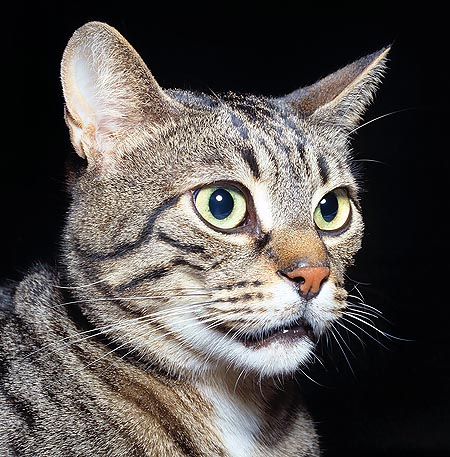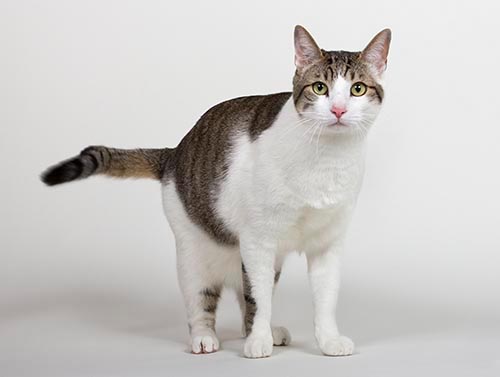Family : Felidae

Text © Dr Didier Hallépée

English translation by Mario Beltramini
Leaving the Nile, the domestic cat (Felis silvestris catus), descendant from the African Wildcat (Felis silvestris lybica), has followed the mercantile routes travelled by the caravans, has gone in board the vessels and has travelled along with the Roman legions going back to Rome. From there, it has gradually spread across Europe and much later the New World. Patron of harvests in Egypt, it has become hunter of rats and other noxious animals in the old continent, assuming in this way a modest role against the propagation of the spread of the black plague. Utility animal for a long time, it has lived more time in proximity of the man than with him. Its reputation of a diabolic animal and its role of witches familiar have sometimes earned it many disappointments.
In Europe, the cat has kept the genetic diversity of its origins and has, on one hand, enriched it while adapting to the extreme conditions of some countries, and on the other, crossing, at times, with its cousin, the European Wildcat (Felis silvestris silvestris). It becomes a pet starting from the sixteenth century. By the twentieth century, the progress in the struggle against the rats in the cities and then in the rural areas, gradually puts an end to its utilitarian role and render it a pleasure animal even if there are still some populations of cats roaming free in our built-up areas.

European shorthair © Giuseppe Mazza
During the nineteenth and twentieth centuries, there is the growth of the purebred cats, the research for the standard, the beauty and of originality at times.
By around the end of the twentieth century, finally, they realized what a treasure was our housecat. In spite of an ample variety of colours and a very rich genetic pool, it has a rather homogenous morphology, which has led to his being elevated to the rank of breed. As a cat of breed, it has been designated as European cat, later on as European Shorthair.
Little things differentiate our traditional domestic cat from the European bred cat: it is the conformity to a standard and the existence of a filiation certified by a pedigree which create the difference.
In other parts of the world, the domestic cat has had a slightly different evolution and had been able to acquire local characteristics slightly different. Also there, the treasure so formed over time has been finally recognized and so were born the British shorthair, the American shorthair or the Arabian mau.
Character
The European cat is robust, agile, rustic and playful, capable to easily adapt to new situations.
From its feline past, it keeps its artful, curious, valiant, at times stealer, character. The kittens are frail upon their birth and need very attentive cares from their mother during their first month and need its presence for about three months. It is from there that it gets it docile and affectionate side, looking for company and for cuddles.
From its feline origins and its past as alley cat, it has kept great qualities as hunter, an instinctive mistrust and a taste for independence and liberty.
Very good explorer, it does not hesitate in going to see what’s going on little far away and gradually widens its territory. But it is also home-staying, very attached to its quarters or house where it always comes back… unless it gets lost.
It is from having been bred in family, manipulated already from its youngest age and covered by love by its human family that renders this cat a company animal particularly loving and attached to man.

The European cat is robust, agile, rustic and playful © Giuseppe Mazza
Grown up without any human contact in its infancy and submitted to the vicissitudes of an alley cat, its instinctive mistrust will gain the upper hand and it will avoid the human contact even if displaying a strange attraction for this funny two-legged animal: it will be tamed and will finally appreciate the vicinity of the man and the comfort of its environment.
It will deign to be petted without, anyway, permitting to be manipulated.
The European shorthair is a cat of breed with the filiation duly certified by a pedigree, grown in a family and with close contact with humans since its birth. So, it keeps the best of its feline origins with all the qualities expected from a companion with which we shall share a good part of our life.
Standard
Longer than wide, the head is rather round with well developed jaws. The front and the skull are slightly rounded. The base of the nose is well defined, without stop but with a slight change of direction.
The nose is straight, of average length and of the same width all over it. Well defined, the muzzle is strong, but without pinch. The chin is firm. From medium to large size, the eyes are rounded and slightly placed aslant. The colour, from orange to yellow and to green, must be the most brilliant, luminous and uniform as possible.
Medium sized, the ears are as high as wide at their base. They are placed rather spaced one from the other and have a tip slightly rounded. Muscled and soft, the neck is of medium size. Of semi-foreign type, the body is from average to big size and rectangular. The chest is wide and well developed. The bone framework is strong and the musculature powerful. The sexual dimorphism is pronounced. The legs are of medium length, strong and solid. Round feet. Thick at its base, the tail is of average length and gets thinner towards a rounded tip. Short, thick and glossy, the fur is lying on the body without undercoat in excess.
Coat
All patterns but colorpoint. All colours but those based on chocolate brown, lilac, cinnamon and fawn.
→ For general notions about Felidae please click here.
→ To appreciate the biodiversity within the CAT BREEDS please click here.
